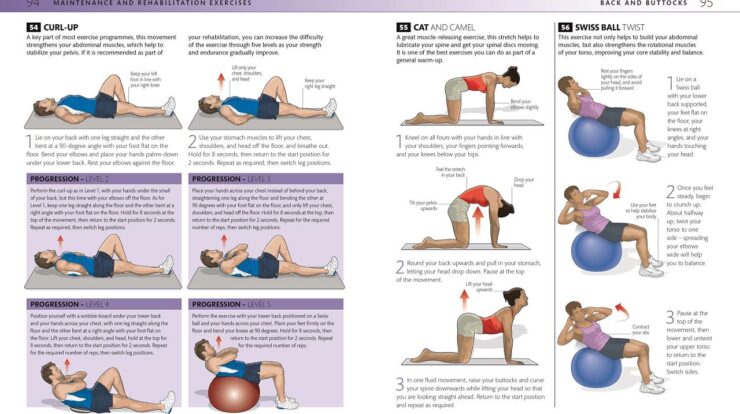
Lower back exercises at home have become increasingly popular as people seek convenient and effective ways to improve their spinal health. This comprehensive guide delves into the benefits, types, equipment, and safety considerations associated with performing lower back exercises in the comfort of your own home.
Don’t forget to give a shoutout to all the strong and amazing back muscles out there. They work hard to keep us upright and pain-free.
From strengthening core muscles to alleviating discomfort, lower back exercises offer a range of advantages that can significantly enhance your overall well-being.
Benefits of Lower Back Exercises at Home

Lower back exercises at home offer numerous benefits, including improved posture, reduced pain, and increased flexibility. By strengthening the muscles that support the lower back, these exercises can help maintain proper spinal alignment, reducing the risk of back pain and injuries.
Additionally, lower back exercises can enhance flexibility and range of motion in the lower back, making it easier to perform everyday activities and reducing the risk of muscle strains and sprains.
Types of Lower Back Exercises
- Bird Dog:Start on all fours, lift your right arm forward and your left leg backward, keeping your back flat and core engaged.
- Superman:Lie on your stomach, lift your arms and legs off the ground simultaneously, and hold for a few seconds.
- Cat-Cow Stretch:Start on all fours, arch your back (cow pose) and then round your back (cat pose), repeating the motion.
- Lower Back Extension:Lie on your stomach, place your hands under your shoulders, and lift your upper body, keeping your lower back flat.
- Pelvic Tilt:Lie on your back, bend your knees, and tilt your pelvis upward, flattening your lower back.
Home Equipment for Lower Back Exercises, Lower back exercises at home
Various equipment can enhance lower back exercises at home, including:
- Resistance Bands:Bands provide variable resistance, allowing for progression and targeting specific muscle groups.
- Stability Ball:Using a stability ball challenges core stability and engages the lower back muscles.
- Foam Roller:Foam rolling can help release tension and improve flexibility in the lower back.
- Exercise Mat:A mat provides a comfortable and supportive surface for exercises.
Creating a Lower Back Exercise Routine
To create a personalized lower back exercise routine:
- Frequency:Aim for 2-3 times per week.
- Intensity:Choose exercises that challenge you but allow you to maintain good form.
- Duration:Start with 10-15 minutes per session and gradually increase.
- Warm-up:Begin with 5-10 minutes of light cardio and dynamic stretching.
- Cool-down:End with 5-10 minutes of static stretching.
Safety Considerations for Lower Back Exercises
Proper form and technique are crucial for safe lower back exercises:
- Avoid excessive arching or rounding of the lower back.
- Keep your core engaged throughout the exercises.
- Listen to your body and stop if you experience any pain.
- If you have any underlying back conditions, consult with a healthcare professional before starting an exercise routine.
Sample Lower Back Exercise Program
| Exercise | Sets | Repetitions | Rest |
|---|---|---|---|
| Bird Dog | 3 | 10-12 | 30 seconds |
| Superman | 3 | 10-12 | 30 seconds |
| Cat-Cow Stretch | 3 | 10-12 | 30 seconds |
| Lower Back Extension | 3 | 10-12 | 30 seconds |
| Pelvic Tilt | 3 | 10-12 | 30 seconds |
Last Recap: Lower Back Exercises At Home

Incorporating lower back exercises into your home fitness routine can be a transformative experience, providing lasting benefits for your posture, flexibility, and pain levels. By following the guidelines Artikeld in this guide, you can create a personalized exercise program that meets your specific needs and helps you achieve optimal spinal health.
Regular exercise is widely recognized as the most effective way to prevent flexibility issues. By engaging in regular physical activity, you can improve your range of motion and maintain a healthy level of flexibility. Learn more about the benefits of regular exercise and how it can help you stay flexible at explain why regular exercise is the best way to prevent flexibility issues.
Answers to Common Questions
What are the benefits of doing lower back exercises at home?
Lower back exercises at home can improve posture, reduce pain, increase flexibility, and strengthen core muscles.
What types of lower back exercises can I do at home?
Strengthening your back muscles is essential for maintaining good posture and preventing back pain. By incorporating regular back exercises into your routine, you can improve your overall health and well-being.
There are a variety of lower back exercises that can be done at home, including bridges, planks, squats, and lunges.
What equipment do I need to do lower back exercises at home?
To all the mothers who have made a difference, we say happy mother’s day to you too . Your love and support have shaped our lives in countless ways. Thank you for everything.
You don’t need any special equipment to do lower back exercises at home, but a yoga mat can provide extra comfort and support.
On this special day, let’s celebrate all the wonderful mothers out there. From heartfelt happy mothers day wishes to thoughtful gifts, show your appreciation for the incredible women who have made a difference in our lives.






